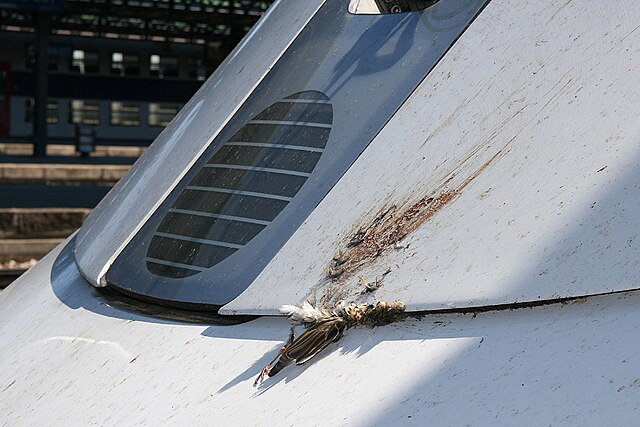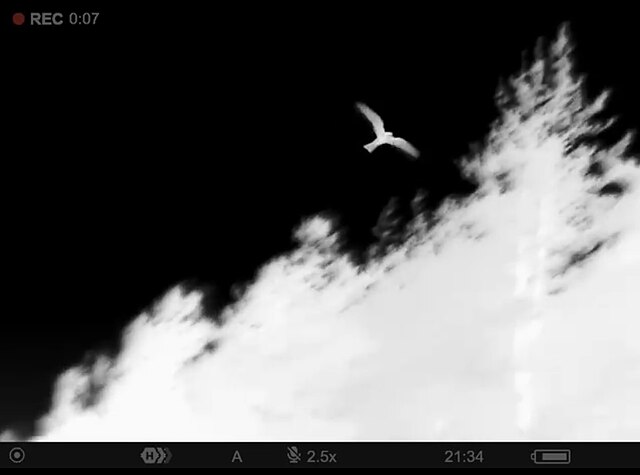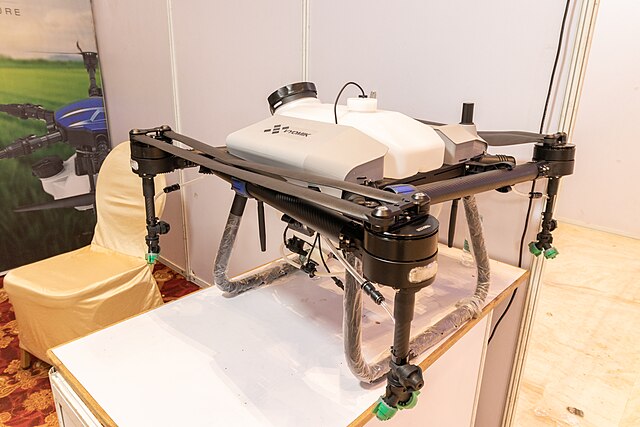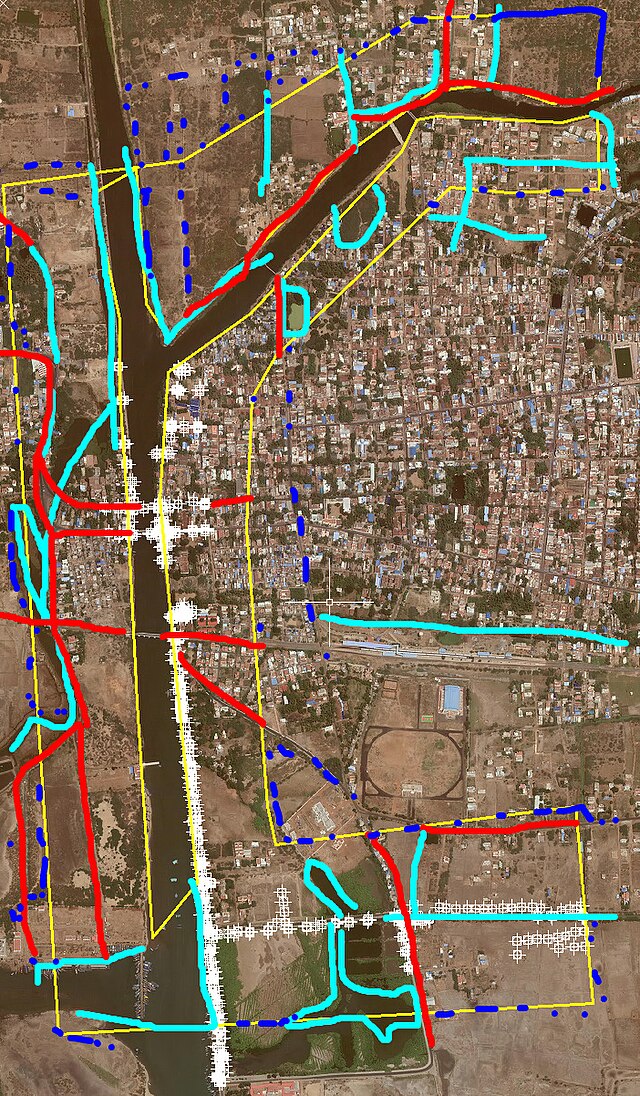
Bird strike on an airplane.
One of the major concerns regarding wildlife is the safety aspect of using airports in areas with natural habitats and water systems. A wildlife strike occurs when an aircraft collides with any living thing such as a bird or animal and these strikes might require an aircraft to be repaired or even turned into ashes because they are quite costly. Safety of Flight and Aviation involves various safety actions, and some safety actions can be used to address the risks of airline flight operations. Thus, using proper WHM techniques would help airports minimize the possibility of wildlife interference as it happens in events that may lead to airline collisions.
In the case of wildlife impacts, a few have relatively negligible impact on the aircraft while several can cause extensive damage to a portion or even an entirety of the structure. In emergencies, the situation makes it impossible for the engine to operate and even to prevent the airplane from going through the air or crashing. These examples highlight the importance of WHM approaches and policies in mitigating potential risks.
Some common wildlife hazards in airports around the world
Something that should be taken seriously is an immediate incident that is related to wild animals and how it is carried out by them. problems that make airport operations around the globe challenging Differences in difficulties based on location include. It is also dependent on the environment in which it grows. Concerning how much people are shifting from one place to another and where they wish to go, an airport location concerns wildlife. Suggests including some relevant information about common risks around the world.
Bird Attacks: This also is a great topic to discuss in terms of threats to birds. This is especially true with animals of large size like ducks, geese, and eagles as they are being affected by size. Similarly, some animals are blamed for the occurrence of the events.
Mammals: Deer, coyotes, and groundhogs are especially dangerous in rural and wooded areas. These animals are most active at dawn and dusk. which corresponds to the maximum flight time
Unique Challenges: Airports or agricultural areas adjacent to wetlands face greater risks because they contain many food sources that attract wildlife.
Europe
Birdwatching: Coastal areas with many seabirds such as gulls and terns. It’s a popular spot for bird watching. Geese and birds of prey are a widespread risk within the country.
Mammals: Foxes, deer, and wild boars frequent the airport area. Especially near forests or agricultural areas.
Seasonal trends: Migratory bird activity increases risk in spring and fall.
Africa
Bird attacks: Large flocks of herons, vultures, and eagles pose a serious threat. Especially in open areas or wildlife sanctuaries where it is rich.
Mammals: Baboons, monkeys, and deer are common risks near airports or reserves.
A unique challenge: Wildlife populations in protected areas can spread to nearby airports. Therefore, high vigilance and appropriate mitigation efforts are required.
Bird Research: Attacks on birds caused by crows, pigeons, waterfowl, and mynas are regular in the densely populated city. Specifically, waterfowl pose threats to air traffic near wetland airports.
Mammals: the notable threats include monkeys, bats, and rodents of tropical and subtropical habitats. Urban sprawl: expanding city zones near the airport levels up the anthropogenic disturbance and wildlife conflict quite exponentially.
Bird defiance: The unique birds of Australia such as cockatoo, magpie, and pelicans bring concern. Large birds foraging the ground, the emus, for example, are also a hazard in rural areas.
Mammals: Operationally kangaroos, wallabies and foxes, and other species. That is a significant concern. True, this condition prevails in underdeveloped countries.
Main risk: The observations reveal that near airports located within rural areas, surrounded by woodland or tillage, there are a lot of attacks by wild animals on airplanes.
South America
Bird conflicts: Citing about vultures, parrots, and waterfowl, birds commonly considered dangers. Ubiquitous among these would be tropical wetlands or rainforests.
Mammals: Capybaras, deer, and rodents. Frequent inhabitation is near water and woods, hence their vulnerability.
Regional Challenges: Airports based in wetlands face threats for most of the year since the location attracts many species due to its biodiversity.
Wildlife hazard management for airports
There remains a significant threat to the safe use of the aviation sector due to habitat and vulnerability issues. The impact of birds and animals, including those that might have crashed into an aircraft, could have disastrous consequences, including injuries and even fatalities as well as great expenses. To manage these threats, airport strategies are implemented on behalf of airports.
Wildlife Hazard Assessment:
This involves the evaluation and identification of the wildlife in the area surrounding and possibly on the airport. Assess the risks of every form of living organism present in the studied landscape to establish the level of danger. The first thing to focus on should be areas with high animal traffic.
Habitat Modification: Change, destroy, or reduce areas that have water or high plant life as well as areas that are rich in food. Avoid plants from acting as shelters. Ensure the use of fencing is done where required to restrain wildlife populations around areas of concern.
Wildlife Deterrence:
Visual Deterrents: Use scare tapes or reflective tape that would scare birds from the area.
Auditory Deterrents: Call as an alarm, play a record of another animal in the same habitat, or use a noise maker.
Pyrotechnics: Use pyrotechnic equipment, like shell crackers, flash-bang devices, etc., to force the birds to fly away.
Lasers: Instead use lasers to deter birds from circling planes.
Wildlife Control:
Trap and Release: Use trapping to control specific cases of animals which should be done accordingly.
Chemical Deterrents: Be cautious of the animals because repellents can be effective for the smells of wild animals.
Monitoring and Response: Establish a protocol to tackle unusual events that may occur within the airport’s operations and be prepared to implement the correct actions. An Emergency Response Strategy can be prepared as soon as a certain emergency occurs; thus, preventing emergency response from being a slow and cumbersome process. Draw on the information obtained from the case studies as well as other studies to determine and improve policies related to managing wildlife activities.
Additional Considerations:
Collaboration with Local Wildlife Agencies: Cooperation with wildlife organizations in their approach with their methods to adopt suitable tactics.
Airport Design and Layout: One of the most critical issues to address is how the existing airport structures and plans are integrated with wildlife conservation.
Pilot Awareness: Remind the pilots regarding the risks they will face while operating in areas that are inhabited by wildlife, and tell them about these risks and how to acknowledge them.
Emergency Response Plans: It is important to develop a plan for dealing with wildlife strikes and how one would go about losing property after the strike. To prevent wildlife-related issues the implementation of a WHM program that covers airport-wide initiatives is advisable in airports as well as ensuring the safety of their flights.
Best practices in wildlife hazard management
Responsibilities for the Aerodrome Wildlife Control Program This includes preparing modifications to the habitats as well as addressing different species’ populations.
Review of Aerodrome Features That Attract Wildlife To prevent a potential issue, operators need to know the types of birds and or animals that are a concern in a particular area and evaluate any threat to a particular group of birds or wildlife species present in the aerodrome. Certain indicators of how these animals come into contact with these things and how they should be managed to control the situation or limit the movement of wildlife in these areas can be identified. Wildlife strike prevention specialists may need guidance on how to handle these situations when it comes to the wildlife strike happening on time. It also should be stated and documented what was done and how the goal was attained, plus any outcomes or effects.
Bird/Wildlife Controller Responsibilities Training of the bird or wildlife controller should be done in the area a day before, or even within one hour of the flight departure of an aircraft, or even before the flight or the flight arrival. Movement with a frequency of less than fifteen minutes should be halted by a crew while still at dawn or dusk. As such, the controller is specifically obliged to perform some tasks concerning wildlife and they cannot be involved in other work. It is a good idea for the controller to start the dispersal process in case of frequent movements even earlier so that the runways surrounding the runway can be cleared, and the time for dispersal will be increased to 16 minutes to not be too much time to scatter the wildlife from the runway so that the controller can clear the wildlife area and also to disperse the wildlife before the runway. These should be checked daily at night when runways and taxiways are being used and the presence of animals near the surfaces must be considered, and disconnections need to be made should animals be found there.
Responsibilities for the Aerodrome Wildlife Control Program To guarantee the efficient running of this program, one of the following people could be appointed; the senior leadership of the Aerodrome Wildlife Control Program could handle this task. This will involve, for example, the need for habitat modifications or changes that may have to be carried out and/or the adjustment of population levels of certain species that may need to be managed for specific aims.
Review of Aerodrome Features That Attract Wildlife It is also important for the aerodrome operators to identify the birds or wildlife in the nearby area that may pose threats. Such a model involves recognizing the needs that must be satisfied, which can mean finding suitable places to feed and build shelter, and then devising ways to limit or eliminate these requirements. This is because the best way to manage such animals is to understand how they act when there are attractants around them and undertake measures that will prevent them from venturing into and around the aerodrome. If you consult professionals for wildlife protection they are recommended to provide their assistance. Data should be captured and recorded every time and recorded again for the sake of completeness.
Bird/Wildlife Controller Responsibilities The controllers or bird/wildlife handlers need to be equipped with adequate training and not be left waiting for deployment only after the operations of the aircraft commence to manage wildlife-related issues effectively. They should be put down a day before or about one hour before flights are going to leave or arrive. Those flights that fall into the range of their scheduled intervals of not more than 15 minutes are defined by the constant attention at dawn and dusk. During these shifts controllers should be standing on their feet as well as have their toes pointing, thus no other work is to be done in this period. While trying not to involve people, if possible, to carry out dispersal operations earlier, such as even before the frequency of aircraft movements increases, this should be done whenever the latter occurs. The main purpose of wildlife exclusion is to ensure a sufficient level of the removal of wildlife from critical areas, like the runway and surrounding environments. During the night; all of the active runways and taxiways should also be checked for the presence of any wildlife. Any wildlife in these areas should be rapidly taken away from the surfaces and not allowed back into them. It addresses the concerns that passengers and employees could face and at the same time ensures that airports are better in terms of productivity and efficiency.
Defining Bird/Wildlife Incidents In this group, some events are further defined and separated into three types: The last aspect taken into consideration when determining the likelihood of such an impact is the presence of a dead bird or other form of wildlife in the movement area; this, under circumstances where any other factor is present, is considered a dead animal and the death is presumed. Unconfirmed Strikes: Collision between an aircraft and a bird or a bird of prey, without conclusive evidence on which to base this claim. Serious Incidents: The possibility of the presence of birds or wildlife affecting the safety of a flight is a flight of birds and even if such happened, then some conditions will force the airline to pull out a plane before the strike is recorded.
Reporting Bird/Wildlife Strikes The airports should establish a system through which the authorities will be notified about all the instances in which birds and wildlife fly near the aerodrome. I want to explain that the number that has been provided should not be taken as an indicator of the risk level or the degree to which the protection measures have been effective in preventing wildlife attacks. It is suggested that the reports made should capture the details relevant to the bird species that struck the plane, and more importantly, the forms for reporting should be followed as they have been standardized by the ICAO. The National Aviation Authorities should be accountable for the collection and providing an annual report by the ICAO on wildlife-related incidents.
Risk Assessment of Wildlife Strike Hazards The operator of the aerodrome should conduct an assessment of potential risks in the event of a wildlife strike and develop and utilize the information for enhanced protection of wildlife from the risk posed by the strikes. It has to evaluate how effective it is through the application of some measures and review it once a year.
Inventory of Wildlife Attracting Sites Near 13km from Aerodrome Location This should also help ensure the identification of locations of wildlife-attracting sites in an area roughly 13 km away from the aerodrome in terms of nature. It should be noted that there are steps that need to be taken regarding the assessment of potential risks if certain types of bird or wildlife activity can cause disturbances in an airline route. If such risks are identified, the organization in charge of wildlife management should develop strategic plans for the site which could be reduced through the implementation of mitigation steps or increased risk analysis to assess the efficacy of the measures. Hence, the process of determining actual risks involved periodically to reflect them.
How wildlife hazard management prevents bird strikes
The WHM programs have various approaches to deal with the possible problems related to wildlife in the aviation industry. These include:
Habitat Modification
Vegetation Management: Removing vegetation near the runways or taxiways to reduce nesting sites and places where birds hide.
Water Management: Closing or pouring the water in the area and minimizing the attractiveness of water bodies for the bird population.
Fencing: It is employed for safeguarding wildlife in particular areas of the airport in which they may potentially access critical facilities.
Wildlife Deterrence
Visual Deterrents: The use of bright clothing to scare off birds.
Auditory Deterrents: This entails the use of devices that elicit fear or sound or loud noise that may scare off birds.
Pyrotechnics: In other forms of avian stimulation, it should be noted that a person can wear shell crackers and flash-bang devices, also by wearing other tools like flash-bang systems, the birds are going to be terrified.
Lasers: However, as in the above quotation, instead, the author recommends that laser beams be used to keep birds away from the area where the aircraft is to be landed.
Wildlife Control
Trapping and Removal: To control birds or animals that people fear.
Chemical Deterrents: Application of repellents and aversive chemicals in the vicinity to reduce frequencies in the airport zones.
Monitoring and Response
Maintenance: This entails scheduling visits to the premises regularly to evaluate wildlife activities within the runway area as well as in and around the surrounding structures.
Rapid Response: Any threat created by wildlife should be anticipated quickly and acted swiftly without any pause for consideration.
Data Analysis: Gathering and processing data on the incidents in wildlife, as the main goal would be to determine the pattern of change.
Pilot Awareness
Training: Inform the pilots about the dangers of wildlife and also tell the pilots how to react when wild animals are flying near the aircraft.
Reporting: Organising and disseminating the information to pilots concerning the wildlife observation during the previous days or nights as they may come to understand the severity of the situation that could follow and they should prepare to address the future threats.
These initiatives will help reduce the risks associated with WHM programs to wildlife, prevent bird strikes, and promote aviation safety for birds within the sector.
Wildlife management strategies for aviation safety
The first concern with the control of animals that may affect the operation of an aircraft at the aerodrome would involve quantifying the danger posed by a certain species of animal to a particular type of aircraft. So, it is not just a basic species identification and surrounding the area, it includes determining probabilities of encountering these species and the potential hazards arising from it, to put it bluntly, the likelihood and effect of the same event. This is why one might see that certain types of species are more important than others, particularly in terms of threats they pose, for which individuals have a professional obligation. Other factors that would help the assessment to assess whether certain species of wildlife are a potential danger to the safety of air transport should include biological traits that are mentioned above. These can be identified and incorporated into the Wildlife Hazard Management Plan to prevent these hazards. It can also be done in different ways to provide information on the likelihood of the attack of the aircraft and the effects of the same attack. (ICAO, 2012)
Technologies in wildlife hazard management
Among these factors, the utilization of technology has been identified as a key factor in improving wildlife management approaches concerning reducing the risks associated with aviation activities. Technology being employed includes:
Thermal Imaging Cameras: Thermal imaging has some basic applications when it comes to the identification of wild animals since heat emissions in animal bodies emit thermal radiation which can be detected by some thermal imaging devices during the nighttime hunting due to heat.

Thermal imaging is done to detect birds.
Acoustic Monitoring: Uses voice microphones to capture the vocal calls of animals for instance monitoring the calls of birds to locate the regions of high wildlife activity.
Drone Surveillance: Enables the use of aerial searches of airports and nearby areas to locate issues such as potential hazards or species that fly around airports.

Drones can be used for surveying animals to prevent bird and animal casualties.
Deterrent Technologies
Direct Beam Laser Deterrents: Directed beams of the laser are used to get birds out of the area near the airport.
Acoustic Deterrents: Install devices that produce intense high-pitched sounds that make the birds and other animals uncomfortable to be around.
Pyrotechnics: Loud noises and flashes to scare birds.
Falconry: This means you need to train your falcons for different tasks, such as killing other birds in a particular flock as well as helping to control a few other bird species in the area.
Data Analysis and Decision-Support Tools
GIS: A method used to create maps that can help locate points where wildlife occurs and therefore plan how to manage the wildlife.

GIS can be used to locate animal and bird habitats and be avoided by flying.
Wildlife Strike Databases: Create an inventory to determine how common incidents can take place regarding the threats that exist.
Artificial Intelligence (AI) and Machine Learning: This can include data from radar, camera, and acoustical sensors that provide insights into wildlife behavior and patterns.
The adoption of these technologies will also contribute to the development of better wildlife hazard management systems that will reduce the chances of bird strikes and other wildlife-related hazards.
Regulations for Wildlife Hazard Management
The issue of wildlife control among different international and regional aviation authorities has been addressed and these norms have been formulated. Underneath there are several types of organizations and associated regulations listed below:
ICAO Annex 14: This annex sets out recommendations on wildlife management due to threats to aviation and other associated fields.
ICAO Wildlife Hazard Management Document: Provides a great overview of the different types of dangers that can affect wildlife, including how and when to take action on those dangers and how to protect them from future dangers.
Federal Aviation Administration (FAA) -FAA, FAA regulations
14 CFR Part 139 – Some basic guidance for airport operators is provided, as you observed, in the development of wildlife hazard management strategies through measures such as conducting wildlife hazard assessments, developing wildlife hazard management plans, and implementing measures that are designed to help protect wildlife.
AC 150/5200-33B: Propose a list of the measures that need to be taken to address potential wildlife problems in the vicinity of airports and other airspace.
AC 150/5200-38: For those who find the above-provided details more informative regarding certain specific steps to undertake when dealing with wildlife hazard assessments and developing management plans, details will be provided later.
EASA regulations: EASA regulations may refer to the ICAO standards and recommended practices alongside the provision of the specific standards and recommended practices in wildlife hazard management within the European Union.
DGCA Directorate General Civil Aviation – India: They include the ICAO standard-setting for airport operators in India and therefore indicate that such operations comprise identifying wildlife threats and designing broad-based management strategies as well as setting appropriate controls.
Another instance is the General Civil Aviation Authority (GCAA) of UAE, which mandates the assessment, risk assessment, management, and enforcement of wildlife risks, and the imposition of wildlife-related restrictions for all the airport operators in the UAE.
Conclusion
If there is any consideration at all it should be with the safety of air traffic and, particularly, how wildlife should not have access to any airport. This is the fact that changes such as environment changes, changes by wildlife, and sometimes by population management. The modern tools for surveillance that are available include thermal cameras, acoustic sensors, and drones that help in locating birds in the area close to the airports. Some of the examples include regulations set by organizations like ICAO, FAA, and EASA regarding the aviation industry, particularly on wildlife and their habitats and on risk assessments, wildlife control, and emergency management planning. In this way, the programs will be able to be implemented successfully across different locations and in a coordinated manner to support their goals in the first place. These include techniques and the use of technology to comply with the regulations and also to fly safer for the passengers, pets, and animals as well as to keep the animals safe. Fundamentally, these practices need to be reviewed and updated to accommodate new challenges related to wildlife threats and to maintain safety for the operations of airports around the world.
